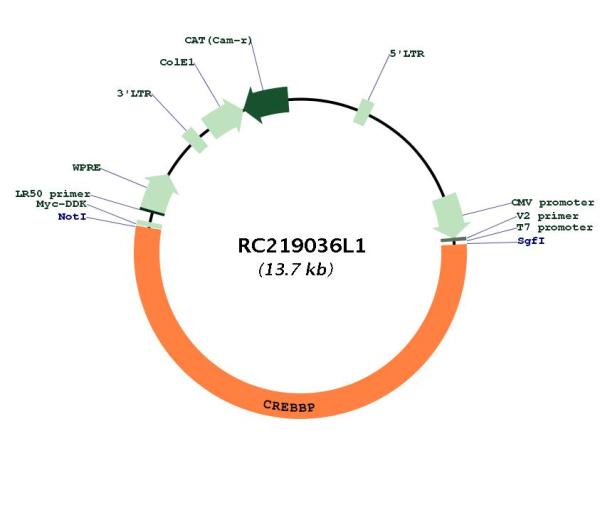KAT3A / CBP (CREBBP) (NM_004380) Human Tagged Lenti ORF Clone
CAT#: RC219036L1
- LentiORF®
Lenti ORF clone of Human CREB binding protein (CREBBP), transcript variant 1, Myc-DDK-tagged
"NM_004380" in other vectors (3)
Specifications
| Product Data | |
| Type | Human Tagged ORF Clone |
| Tag | Myc-DDK |
| Symbol | KAT3A / CBP |
| Synonyms | CBP; KAT3A; MKHK1; RSTS; RSTS1 |
| Vector | pLenti-C-Myc-DDK |
| E. coli Selection | Chloramphenicol (34 ug/mL) |
| Mammalian Cell Selection | None |
| Sequence Data |
The ORF insert of this clone is exactly the same as(RC219036).
|
| Restriction Sites |
SgfI-NotI
Cloning Scheme for this gene
Plasmid Map

|
| ACCN | NM_004380 |
| ORF Size | 7326 bp |
| OTI Disclaimer | Due to the inherent nature of this plasmid, standard methods to replicate additional amounts of DNA in E. coli are highly likely to result in mutations and/or rearrangements. Therefore, OriGene does not guarantee the capability to replicate this plasmid DNA. Additional amounts of DNA can be purchased from OriGene with batch-specific, full-sequence verification at a reduced cost. Please contact our customer care team at custsupport@origene.com or by calling 301.340.3188 option 3 for pricing and delivery. The molecular sequence of this clone aligns with the gene accession number as a point of reference only. However, individual transcript sequences of the same gene can differ through naturally occurring variations (e.g. polymorphisms), each with its own valid existence. This clone is substantially in agreement with the reference, but a complete review of all prevailing variants is recommended prior to use. More info |
| OTI Annotation | This clone was engineered to express the complete ORF with an expression tag. Expression varies depending on the nature of the gene. |
| Product Components | The ORF clone is ion-exchange column purified and shipped in a 2D barcoded Matrix tube containing 10ug of transfection-ready, dried plasmid DNA (reconstitute with 100 ul of water). |
| Reconstitution | 1. Centrifuge at 5,000xg for 5min. 2. Carefully open the tube and add 100ul of sterile water to dissolve the DNA. 3. Close the tube and incubate for 10 minutes at room temperature. 4. Briefly vortex the tube and then do a quick spin (less than 5000xg) to concentrate the liquid at the bottom. 5. Store the suspended plasmid at -20°C. The DNA is stable for at least one year from date of shipping when stored at -20°C. |
| Reference Data | |
| RefSeq | NM_004380.1 |
| RefSeq Size | 8694 bp |
| RefSeq ORF | 7329 bp |
| Locus ID | 1387 |
| UniProt ID | Q92793 |
| Cytogenetics | 16p13.3 |
| Domains | zf-TAZ, ZnF_ZZ, BROMO, KIX |
| Protein Families | Druggable Genome |
| Protein Pathways | Adherens junction, Cell cycle, Huntington's disease, Jak-STAT signaling pathway, Long-term potentiation, Melanogenesis, Notch signaling pathway, Pathways in cancer, Prostate cancer, Renal cell carcinoma, TGF-beta signaling pathway, Wnt signaling pathway |
| MW | 265.2 kDa |
| Gene Summary | This gene is ubiquitously expressed and is involved in the transcriptional coactivation of many different transcription factors. First isolated as a nuclear protein that binds to cAMP-response element binding protein (CREB), this gene is now known to play critical roles in embryonic development, growth control, and homeostasis by coupling chromatin remodeling to transcription factor recognition. The protein encoded by this gene has intrinsic histone acetyltransferase activity and also acts as a scaffold to stabilize additional protein interactions with the transcription complex. This protein acetylates both histone and non-histone proteins. This protein shares regions of very high sequence similarity with protein p300 in its bromodomain, cysteine-histidine-rich regions, and histone acetyltransferase domain. Mutations in this gene cause Rubinstein-Taybi syndrome (RTS). Chromosomal translocations involving this gene have been associated with acute myeloid leukemia. Alternative splicing results in multiple transcript variants encoding different isoforms. [provided by RefSeq, Feb 2009] |
Documents
| Product Manuals |
| FAQs |
| SDS |
Resources
Other Versions
| SKU | Description | Size | Price |
|---|---|---|---|
| RC219036 | CREBBP (Myc-DDK-tagged)-Human CREB binding protein (CREBBP), transcript variant 1 |
USD 3,022.00 |
|
| RG219036 | CREBBP (tGFP-tagged) - Human CREB binding protein (CREBBP), transcript variant 1 |
USD 3,222.00 |
|
| SC308990 | CREBBP (untagged)-Human CREB binding protein (CREBBP), transcript variant 1 |
USD 3,024.00 |
{0} Product Review(s)
Be the first one to submit a review






























































































































































































































































 Germany
Germany
 Japan
Japan
 United Kingdom
United Kingdom
 China
China



